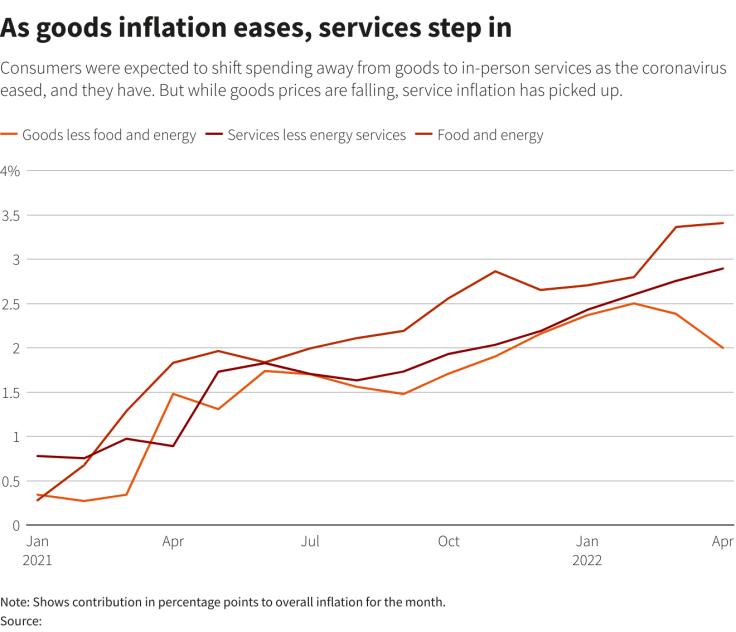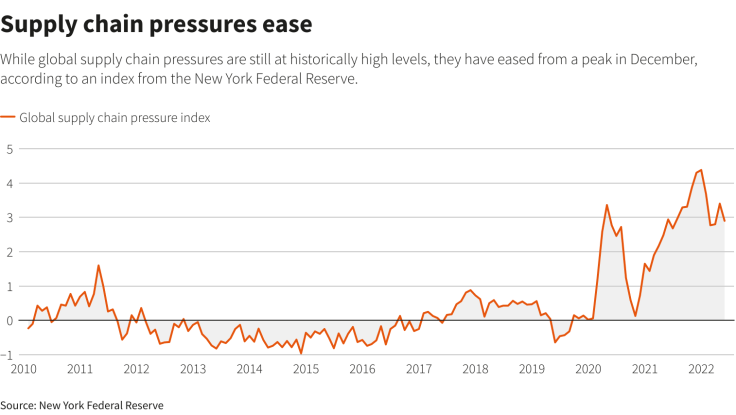As Top U.S. Retailers Drown In Goods, Rotation To Services Picks Up Inflation Slack

Major retailers like Target Corp and Walmart Inc may be cutting prices to clear overstocked warehouses, but for hotel operators the revenue is pouring in with daily room rates and occupancy that have broken above pre-pandemic levels.
The pace of used car price increases has eased from the chart-topping levels that drove an initial surge of COVID-era inflation; but airline fares as of April were rising at a similarly stratospheric 33% annual rate.
The price of restaurant meals is accelerating with no break apparent yet in demand, according to data from reservation site OpenTable.
In the battle against inflation, now front of mind for the Federal Reserve and the Biden administration, the expected rotation of spending from a COVID-lockdown splurge on goods to in-person services was supposed to also take the edge off of prices. Services, after all, are more immune to the supply-chain bottlenecks that kept goods off of shelves and fueled price rises through scarcity.
Instead, the two sides of American consumption are also seeing a handoff in inflation pressure - at least so far - with the more wage-senstive service industry competing for workers to fill vacancies that remain well above the national job opening rate.
For the Fed, as well as Democrats worried inflation will cost them at the mid-term polls in November, the "great rotation" so far is providing no easy fix.
Graphic: As goods inflation eases, services step in -

"A rise in consumption back towards services may not help much," given higher labor demand and higher wage growth in the service industry, said Harry Holzer, a Georgetown University economics professor and Brookings Institution fellow. "Wage inflation there is stronger in a range of sectors from the low end...to the high end" - from restaurant workers to well-paid professionals.
New consumer inflation data due Friday is expected to show headline prices continued to rise by 8.3% annually, a multi-decade price shock that has cut Americans' purchasing power and led to challenging increases in food costs and gasoline nearing $5 a gallon.
The Fed uses a slightly different measure for its 2% inflation target, but it is running at 6%, causing the Fed to engineer one of its fastest-ever turns toward tighter monetary policy - all with President Joe Biden's blessing in hopes prices will ease soon.
'OPTIMISTIC FOR THE CONSUMER'
Within the headline number, however, the subtext may be even more troublesome.
Inflation for goods has eased as expected, with demand falling and growing evidence that the supply-chain problems that bedeviled the global economy last year are improving.
Shipping costs and port backlogs are easing, and a New York Fed index of overall supply chain stress eased through May, resuming improvement seen at the start of the year.
Monthly e-commerce data from Adobe, released Thursday, showed inflation for goods purchased online eased in May to a 2% annual rate, down from a March peak of 3.6%. Prices fell on a month to month basis for 10 of the 18 categories tracked by the company. Rising online prices were a hallmark of the COVID goods binge.
Graphic: Supply chain pressures ease -

But services are taking up the slack. Excluding energy-related services, inflation for "core" services has accelerated for eight months straight, and their share of overall inflation has risen also.
So far that has not clearly dented consumer spending, though "real" purchases adjusted for inflation may have slipped a bit, according to a Bank of America Institute study of credit card spending.
"As we hunt around the data for bearish signs, we are still struck by strong momentum in service sector spending," the report said. "Additionally, households' median checking and savings accounts are higher than pre-pandemic...Overall, we remain cautiously optimistic for the consumer."
The financial buffers built during the pandemic indeed may prove a key factor in the success or failure of efforts to tame inflation, with households by some estimates still sitting on a few trillion dollars of extra cash from pandemic-era transfer payments or spending trimmed during the health crisis.
That's firepower to keep consumption underway - whether meeting the higher mortgage payments home buyers must shoulder as interest rates rise or, as Bank of America noted, funding higher gas prices at the expense of things like consumer durables where demand was expected to wane anyway.
FAST ENOUGH?
It's not a clear-cut picture.
In a presentation in late May, Pantheon Macroeconomics Chief Economist Ian Shepherdson laid out the case that has placed him among the inflation optimists: A combination of improving supply chains, an expected slowing of home price appreciation, pressure on profits due to rising inventories, and slower wage growth could cause CPI to fall below 3% by early next year.
Signs of that, he maintains, could show up in time for the Fed to slow its current half-point pace of rate increases to a quarter point by this fall, and perhaps as soon as the central bank's July meeting.
"If you were building an inflation model from the bottom up, all these variables that you would consider are starting to move in the right direction," he said.
But the pace of improvement will matter. Fed officials have said they want convincing, month-to-month proof inflation is easing before slowing their rate increases. For politicians, $5 dollar gas heading into the summer driving season and ahead of midterm congressional elections is a painful campaign statistic.
Change may not happen fast, Citi economists Veronica Clark and Andrew Hollenhorst wrote.
They see prices continuing to rise around 8.3% annually in Friday's upcoming report, "with upside risks and a continued pick-up in services prices. A pick up in services inflation would be a further sign that too-tight labor markets are a key factor driving high inflation" that could prompt the Fed to keep its faster rate hikes intact.
© Copyright Thomson Reuters {{Year}}. All rights reserved.





















